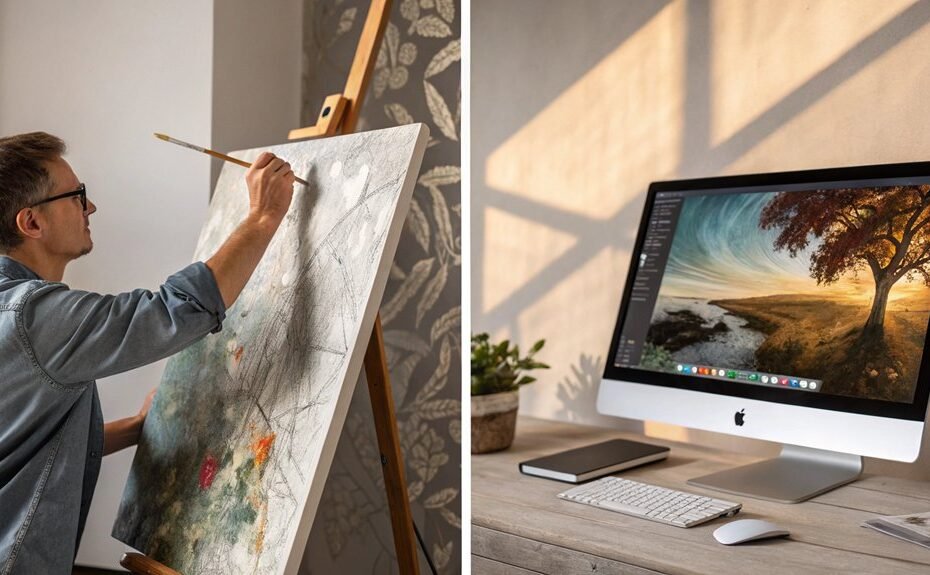AI art differs from human-created artwork in three fundamental ways. First, AI relies on algorithmic processes and data analysis, while human artists draw from personal experiences and emotional depth. Second, human artists make intentional creative decisions that reflect cultural understanding and symbolic meaning, whereas AI mimics patterns without true comprehension. Third, technical execution varies considerably – human art incorporates natural imperfections and unique textures, while AI work shows precise but often repetitive patterns. Further exploration reveals additional nuances in this emerging artistic divide.
As artificial intelligence continues to reshape creative industries, the fundamental differences between AI-generated and human-created art have become increasingly apparent. The distinction manifests primarily in the creation process, where AI relies on algorithmic mechanisms and machine learning, while human artists employ traditional methods and emotional expression.
AI art generation occurs through neural networks processing vast datasets, whereas human artists draw from personal experiences, cultural understanding, and intentional creative decisions. Language generation models are becoming increasingly sophisticated in their ability to understand and interpret artistic elements, pointing to continued evolution through 2025.
The emotional and conceptual depth represents another vital differentiating factor between AI and human art. Human artists infuse their work with authentic emotions, personal narratives, and cultural significance, creating pieces that reflect social contexts and historical meanings. Popular AI art tools like Jasper and DALLE-2 enable rapid creation of unique artworks that challenge traditional artistic boundaries.
Conversely, AI art, while capable of mimicking emotional elements, lacks genuine emotional understanding and operates purely through pattern recognition and data analysis. This limitation becomes evident in the artwork's symbolic depth and narrative complexity, where human artists consistently demonstrate superior ability to convey nuanced messages and cultural references.
Technical characteristics further distinguish AI art from human-created works. Human art naturally incorporates imperfections, unique textures, and deliberate stylistic choices that reflect individual artistic vision.
AI-generated art, while precise and consistent, often exhibits repetitive patterns and struggles with intricate details, sometimes producing an "uncanny valley" effect in its attempts to replicate human creativity. The resource efficiency of AI art production, requiring minimal time and cost compared to traditional methods, presents both advantages and limitations in the creative process.
Furthermore, public perception reveals a persistent preference for human-created art, even when viewers cannot definitively identify the creator. This bias stems from the stronger emotional connections and personal resonance that human art typically evokes in its audience.
In spite of these distinctions, AI's role in art creation continues to evolve, offering new possibilities for collaborative creation and artistic innovation, while maintaining clear differences from traditional human artistic expression.
Most-Asked Questions FAQ
Can AI Art Be Considered Original if It Learns From Human Artwork?
AI art's originality remains debatable since it synthesizes existing human artworks, creating derivative combinations rather than truly novel creations born from personal experience and emotional depth.
Will AI Art Eventually Replace Human Artists in the Commercial Market?
AI art may complement but unlikely to fully replace human artists. The commercial market values emotional depth, originality, and cultural significance that human artists uniquely provide through their creative work.
How Do Copyright Laws Protect Ai-Generated Artwork?
Current U.S. copyright laws do not protect AI-generated artwork. Works must have human authorship to qualify for copyright protection. AI outputs without substantial human creative input remain unprotected.
Can AI Develop Its Own Unique Artistic Style Without Human Influence?
AI cannot develop truly unique artistic styles independently, as its output relies entirely on human-created training data and algorithms designed by humans to process and recombine existing artistic elements.
What Emotional Value Can AI Art Hold Compared to Human-Created Pieces?
AI art can evoke emotional responses through patterns and compositions, but typically lacks the personal narrative and authentic emotional depth that humans naturally embed in their artistic creations.
